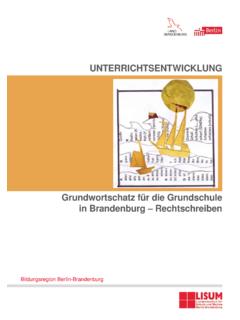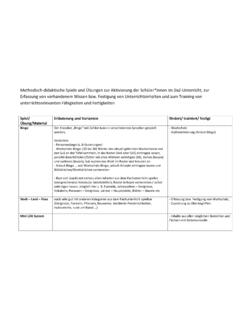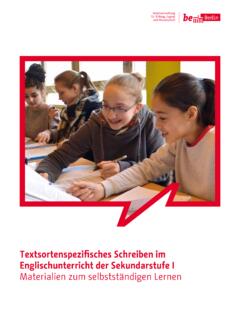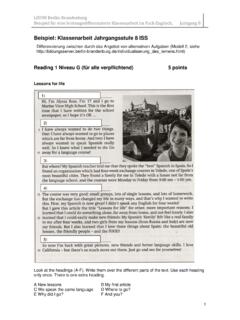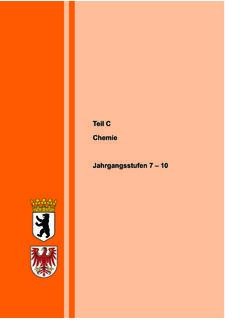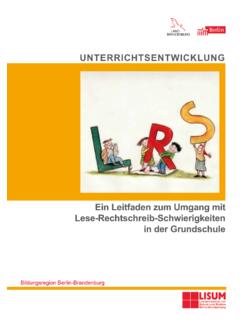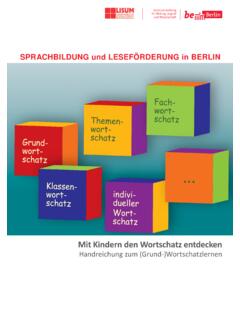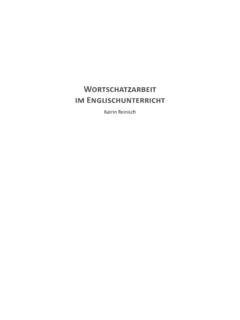Transcription of Materialien zum selbstständigen standardorientierten ...
1 MATERIALIENzum selbstst ndigen standardorientierten lernen in der gymnasialen Oberstufe im Fach Englisch Text production Impressum Herausgeber Senatsverwaltung f r Bildung, Jugend und Familie Bernhard-Wei -Stra e 6, 10178 Berlin Verantwortlich Regina Ultze Redaktion Sabine Luthe, Dr. Dorothea N th Autorinnen und Autoren Beate Eisner, Dr. Nicoline Fl , Christine Merkel, Susanne Mundt, Olaf Malecki, Sabine Luthe, Dr. Dorothea N th, Carol Renner, Lothar Schmitt, Doris Stegmann, Simone Vogler, Ronald Wappke, Eva Weinert Beispieltexte basierend auf Texten von Sch lerinnen und Sch lern des Paul-Natorp-Gymnasiums bereitgestellt von Susanne Mundt Muttersprachliche Pr fung Dr. Eric Denton Dank Wir danken allen Kolleginnen und Kollegen, die mit ihrem konstruktiven Feedback zur Verbesserung der aktuellen Auflage beigetragen haben. Umschlaggestaltung SenBJF ZS I Foto Shutterstock (Rido) Neuauflage 05/2021 3 Vorwort Die vergangenen Jahre waren auch f r den Englischunterricht gepr gt von vielen Ver nderungen, die sich in neuen Bildungsstandards f r die Allgemeine Hochschulreife, Rahmenlehrpl nen, Bewertungssystemen, Lernstandserhebungen, zentralen Pr fungen und einem gemeinsamen Abituraufgabenpool der L nder widerspiegeln.
2 Mittlerweile hat vieles den Praxistest bestanden, was zu Beginn noch Unsicherheit und Misstrauen erzeugte, und wird von Lehrenden und Lernenden erfolgreich angewendet. Trotzdem m ssen wir uns weiter bem hen, die Sch lerinnen und Sch ler immer besser zu bef higen, die an sie gestellten Anforderungen zu erf llen. Dabei geht es nicht nur um ihr gutes Abschneiden in Pr fungen. Ziel des kompetenzorientierten Lernens, der standardorientierten Pr fungen und Vergleichsarbeiten ist es, den Lernenden eine optimale Vorbereitung auf Studium, Ausbildung und Beruf zu erm glichen. Dar ber hinaus soll die Besch ftigung mit aktuellen Themen und die Nutzung moderner Medien im Unterricht dazu beitragen, dass das lernen in der Schule in erfolgreiche, selbstbestimmte und individuell befriedigende Lebenswege m ndet. Um dies zu erreichen, m ssen Sch lerinnen und Sch ler auch Techniken lebenslangen Lernens trainieren, denn nur so k nnen sie die Herausforderungen des globalisierten Zeitalters bestehen.
3 Der so oft geforderte erstklassige Unterricht, der diesen Erwartungen gerecht wird, ist nicht allein Ergebnis intensiver Vorbereitung der Unterrichtenden und Nutzung motivierender Materialien und Medien. Entscheidend f r den Erfolg von Unterricht ist es auch, dass Sch lerinnen und Sch ler bereit sind, ihren Lernprozess zunehmend selbst in die Hand zu nehmen. Dies bedeutet, dass sie sich zun chst bewusst werden, wo ihre St rken und Schw chen liegen. Aus diesem Wissen k nnen sie selbst ableiten, in welchen Bereichen sie bungsbedarf haben und m glichst auch, welche Art des bens f r sie geeignet ist. Individualisiertes lernen verlangt aber dar ber hinaus, dass Sch lerinnen und Sch ler wissen, was von ihnen verlangt wird. Das vorliegende Material zum selbstst ndigen lernen im Englischunterricht soll einen Beitrag in diesem Sinne liefern: Es bietet den Lernenden eine Grundlage, um eigenst ndig festzustellen, wo f r sie bungsbedarf besteht.
4 Zus tzlich werden praktische Tipps, Hinweise und Beispieltexte f r den indivi duellen bungsprozess im Bereich Schreiben in der Sekundarstufe II bereitgestellt. Dar ber hinaus bietet das vorliegende Material Sch lerinnen und Sch lern die M glichkeit, Selbsteinsch tzung zu trainieren, Kriterien f r die Bewertung der Ergebnisse eigener Arbeit zu entwickeln und anzuwenden und somit im Sinne der zu erreichenden Standards ihre Kompetenzen weiterzuentwickeln. 4 Content page 1 Introduction 6 Note to the teacher 6 Note to the student 7 2 Summing up and outlining information 8 Writing a summary 8 Criteria for summary writing 8 Sample summary 9 Self-assessment grid: Summary writing 10 Outlining information 11 Criteria for outlining information 11 Sample outline 12 Self-assessment grid: Outlining information 13 3 Analyzing texts 14 Analyzing written texts 14 Criteria for analyzing written texts 14 What to focus on when analyzing written texts 16 Sample analysis 17 Self-assessment grid: Analyzing written texts 18 Analyzing pictures (cartoons, photographs, paintings, drawings) 19 Criteria for analyzing pictures (cartoons, photographs, paintings, drawings) 19 Useful expressions for writing about a picture (cartoon, photograph, painting, drawing) 20 Self-assessment grid.
5 Analyzing pictures (cartoons, photographs, paintings, drawings) 22 Analyzing graphs, charts and tables 23 Criteria for analyzing graphs, charts and tables 23 Useful expressions for writing about graphs, charts and tables 24 Self-assessment grid: Analyzing graphs, charts and tables 27 4 Comparing and contrasting texts 28 Relating visual material to written texts 28 Criteria for relating visual material to written texts 28 Self-assessment grid: Relating visual material to written texts 30 Comparing literary texts / films / real-life experiences 32 Criteria for comparing literary texts / films / real-life experiences 32 Self-assessment grid: Comparing literary texts / films / real-life experiences 34 5 Discussing and commenting on an issue 35 Discussing and commenting on an issue 35 Criteria for discussing and commenting on an issue, a quote or a cartoon 35 Self-assessment grid: Discussing and commenting on an issue 36 Writing an article 37 Criteria for writing an article 37 Sample article 39 Self-assessment grid: Writing an article 40 Writing a blog entry 42 Criteria for writing a blog entry 42 Sample blog entry 44 Self-assessment grid: Writing a blog entry 45 5 7 General advice on writing 74 Preparation 74 Writing stages 74 Using graphic organizers to get started 75 Dealing with vocabulary problems Using dictionaries 78 Linking ideas and sentences 81 Quoting and referencing 84 Self-assessment grid.
6 Revising written texts 86 How to improve your writing 88 8 Operatoren der gymnasialen Oberstufe 89 Reproduktion und Textverstehen 89 Reorganisation und Analyse 90 Diskussion und Kommentar 91 Sprachmittlung 91 Gestalten 92 9 References 93 10 Documentation section 95 Writing an email 46 Criteria for writing an email 46 Sample email 48 Self-assessment grid: Writing an email 49 Writing a letter 50 Criteria for writing a letter 50 Sample letter 52 Self-assessment grid: Writing a letter 53 Writing a letter to the editor 54 Criteria for writing a letter to the editor 54 Sample letter to the editor 56 Self-assessment grid: Writing a letter to the editor 57 Writing a speech 58 Criteria for writing a speech 58 Using rhetorical devices 60 Sample speech 61 Self-assessment grid: Writing a speech 62 6 Mediation 64 Summing up information from a German text 64 General criteria for summing up information from a German text 64 Self-assessment grid: Summing up information from a German text 65 Writing an email summing up information from a German text 66 Criteria for writing an email summing up information from a German text 66 Self-assessment grid: Writing an email summing up information from a German text 67 Writing an article summing up information from a German text 68 Criteria for writing an article summing up information from a German text 68 How to begin and end an article (mediation) 69 Self-assessment grid.
7 Writing an article summing up information from a German text 70 Writing a blog entry summing up information from a German text 71 Criteria for writing a blog entry summing up information from a German text 71 How to begin and end a blog entry (mediation) 72 Self-assessment grid: Writing a blog entry summing up information from a German text 73 6 1 Introduction Note to the teacher Learner autonomy is essential for successful work in the English classroom. Therefore, self-evaluation and self-correction are necessary prerequisites for individual work. Students must be enabled to critically examine their own work and to evaluate it with the aim of taking the necessary steps to improve their competencies. This material is meant to help students develop their skills in working with texts and to improve their ability for self-evaluation and self-correction. In contrast to most of the current material used in the classroom, it does not only list criteria for various genres required in the curriculum, such as analysis, comment or letter to the editor, it also provides supplementary pages with phraseology, sample texts and general advice on writing.
8 In addition, self-assessment grids will help students to revise their own texts. It also helps if they collect successful samples of their work to document their progress. In order to accommodate diverse learning situations, this material consists of learning modules, each containing: criteria for different genres such as comments or emails supplementary pages with useful vocabulary and phrases sample texts self-assessment grids general advice on writing a documentation section in which students collect samples of their own work (usually at least two per genre) to document their learning progress. There is a lot of material here and a lot of things to think about and practice. Your students are not expected to learn all of it at once. Break it up, pick and choose areas of focus in terms of individual weaknesses and reinforcement and support. Guide your students to use it as needed and helpful throughout their two/three years of preparing for their final exams.
9 Of course, you are invited to deal with additional genres in class and to hand out corresponding worksheets to your students. 7 Note to the student Learning by doing is an important way to develop and improve individual skills. Therefore, this material is based on self-evaluation and self-correction. It aims at helping you to examine your own work with a critical eye. As help for checking your work samples, this material consists of criteria for different genres such as comments or e mails supplementary pages with useful vocabulary and phrases sample texts self-assessment grids general advice on writing. Ther e is a lot of material here and a lot of things to think about and practice. You are not expected to learn all of it at once. Break it up and use it as needed and helpful throughout your two/three years of preparing for your final exams. While checking your work, answer the questions on the self-assessment grids and tick: Yes.
10 / Excellent. Good, but can be improved. Satisfactory, but needs some improvement. No. / Needs improvement. To document your progress, you should collect successful samples of your work in the documentation section of this material. 8 2 Summing up and outlining information Summary writing or outlining information means that you briefly pass on the main information of a text to someone who has not read it. The language used must be neutral and objective, paraphrasing the author s main points and providing only the most important details. You may have to a) sum up a complete literary or non-literary text, an excerpt from a text or b) outline certain aspects of a text. Writing a summary Criteria for summary writing If you have to sum up an article, a short story, a novel or an excerpt from any of these genres, present the main information from the original text in a condensed form.
